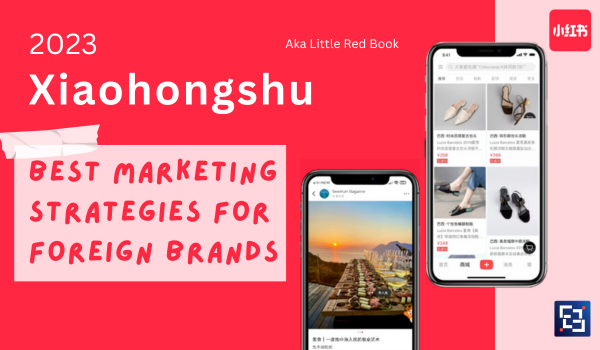
Xiaohongshu (Little Red Book) 2023: Best Marketing Strategies for Foreign Brands
22 November 2023 | Hui C & Shy L| 8 min read
Are you a foreign brand eyeing the thriving Chinese market? You are certainly not alone. With over 50 million daily active users and over 140,000 registered brands on Xiaohongshu, it is easy to see that the “Little Red Book” is making enormous waves in the global market.
But the main question is where to start.
Worry not! Get ready to leverage Xiaohongshu’s unique features and marketing strategies. Grow your brand by blending seamlessly into Xiaohongshu’s aspirational lifestyle world.
- Xiaohongshu 101: An Introduction
- Xiaohongshu User demographics and behaviour
- Xiaohongshu Market Operation
- The Core of Xiaohongshu Explosive Marketing – User Retention and Conversion
- Realising Business Success via Xiaohongshu’s Features
- Strategies for Successful Xiaohongshu Marketing
- What is Next?
- F.A.Q.
Xiaohongshu 101: An Introduction
Xiaohongshu, meaning “Little Red Book” in Chinese, is a lifestyle platform combining social sharing and e-commerce for Mainland China targeted at young, fashion-forward women. With over 100 million female users, Xiaohongshu fosters an engaged community around aspirational content and shopping recommendations.
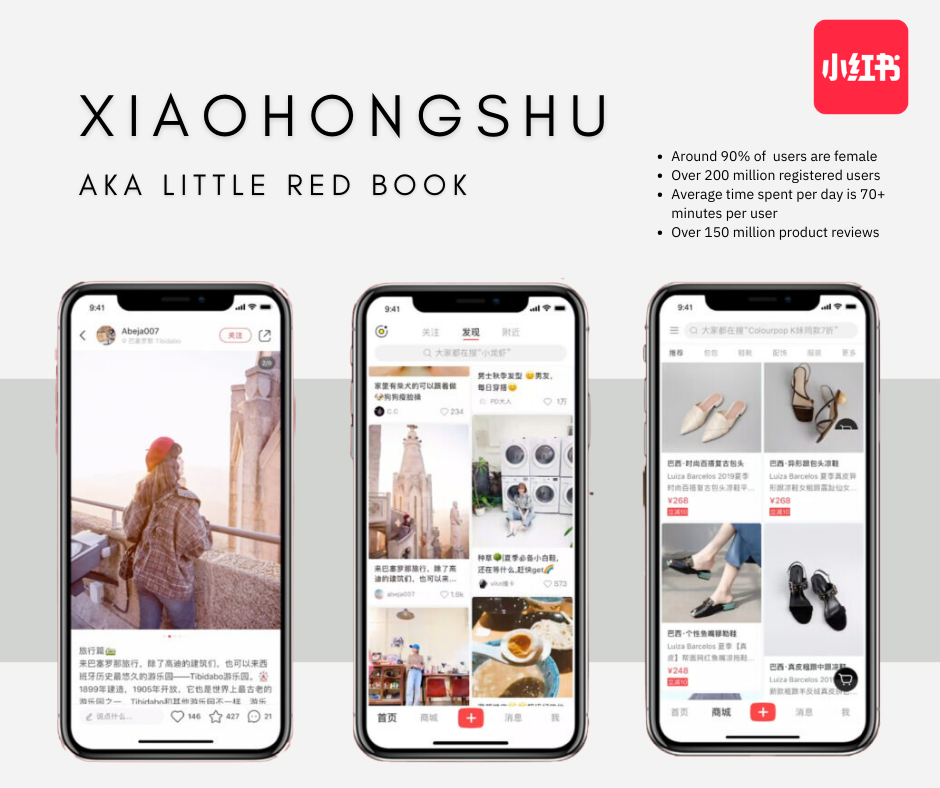
Unlike other traditional advertisements, Xiaohongshu relies on “grass-planting”- authentic, user-generated content that drives desire and conversion. Users can follow friends and influencers, share product reviews, browse curated stores, and purchase featured items seamlessly. Xiaohongshu merges social networking with online shopping in a mobile-first experience tailored for China’s new consumer generation. This unique blend of inspiration and commerce is driving Xiaohongshu’s rapid rise.
Xiaohongshu User demographics and behaviour
Grasping the demographics and consumer behaviour of Xiaohongshu’s user base is key for international brands aiming to thrive on the platform. Analysing these attributes allows brands to intimately understand their target customers and cater to their marketing approach accordingly.
| Demographics | Behaviour |
| 72% users are post-90s urban females who value quality. | – They are likely discerning shoppers who do research and read reviews before making purchases. Building trust through detailed product information will be important.
– As urban females, they have an affinity for fashion and style. Catering to current trends and aesthetics will appeal to them. |
| 50% of users are from first and second-tier cities in China. | – As residents of major metro areas, they are likely digitally savvy and rely on online services for shopping and lifestyle needs. Engage on social platforms comes naturally for them.
– Their higher incomes and urban lifestyles translate to an appetite for premium, high-quality goods and experiences. – Interests in fashion and style, as urban centers provide easy access to luxury markets. |
| With females representing 88.8% of its user base, Xiaohongshu has a heavily female-skewed gender ratio. | – Content focused on female interests like fashion, beauty, lifestyle and relationships is likely to resonate strongly
– This audience values relatability and authenticity. Brand collaborations with creators should feel organic, not forced. – Shopping habits may gravitate toward aspirationally priced contemporary brands that align with their style values. |
| A significant portion of users are under 30 years old. | – As early adopters, they are open to discovering and trying new brands and products.
– Convenience and seamless user experience are very important to these on-the-go users. Simplicity and speed are key. – They are used to interacting and engaging with content. Gamification, contests and challenges can encourage participation. |
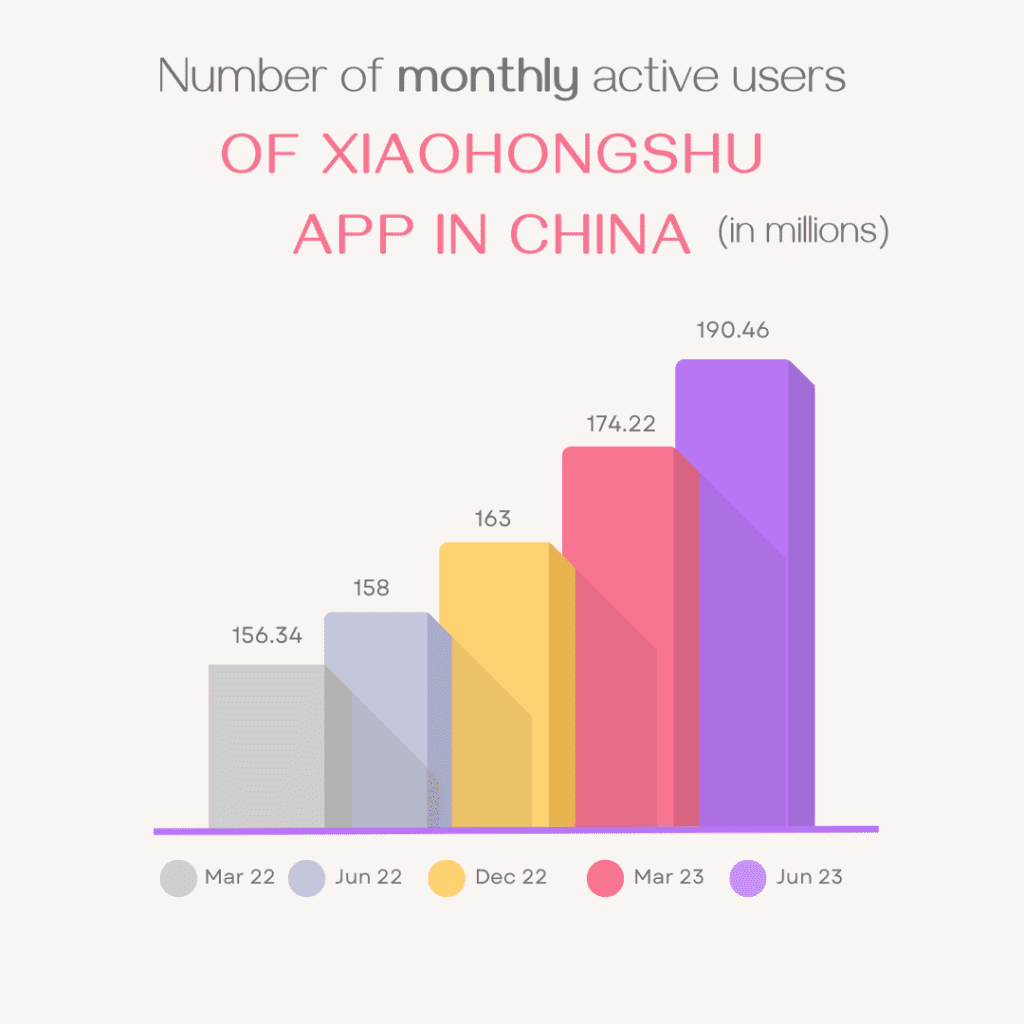
Research Your Target Audience
Xiaohongshu’s platform offers brands a valuable opportunity to connect with Chinese consumers on a deeper level. By sharing personal style posts and authentic reviews, Xiaohongshu has become a go-to for discovering and discussing aspirationally priced foreign brands that resonate with young female consumers. Users become drawn to the app’s relatable, user-generated content that offers an inside look at fashion, beauty, and lifestyle products.
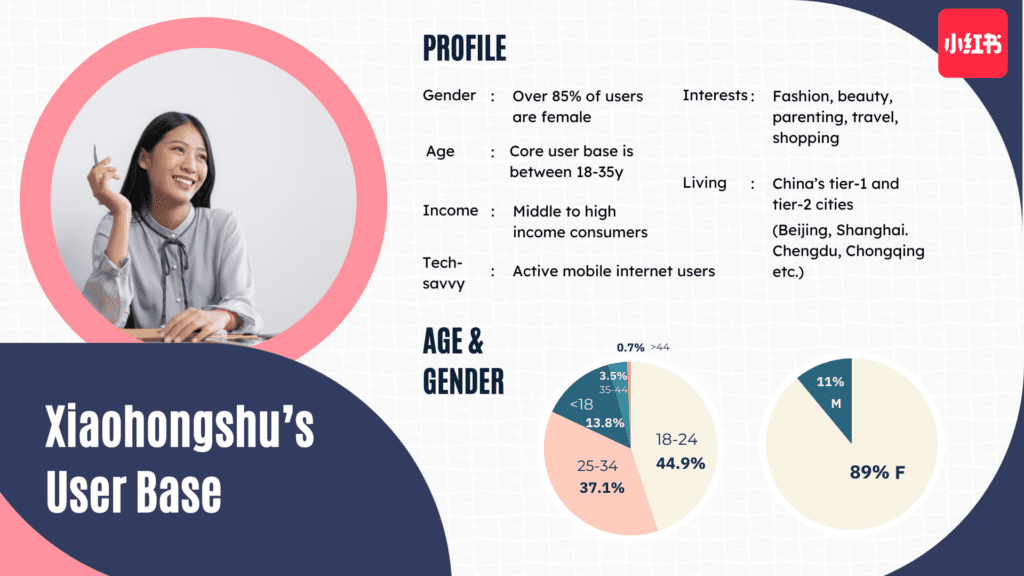
The vibrant community enables users to connect with influencers, experts, and each other to explore new styles and emerging trends. For brands hoping to gain visibility with style-conscious shoppers in this coveted demographic, Xiaohongshu provides an impactful platform.
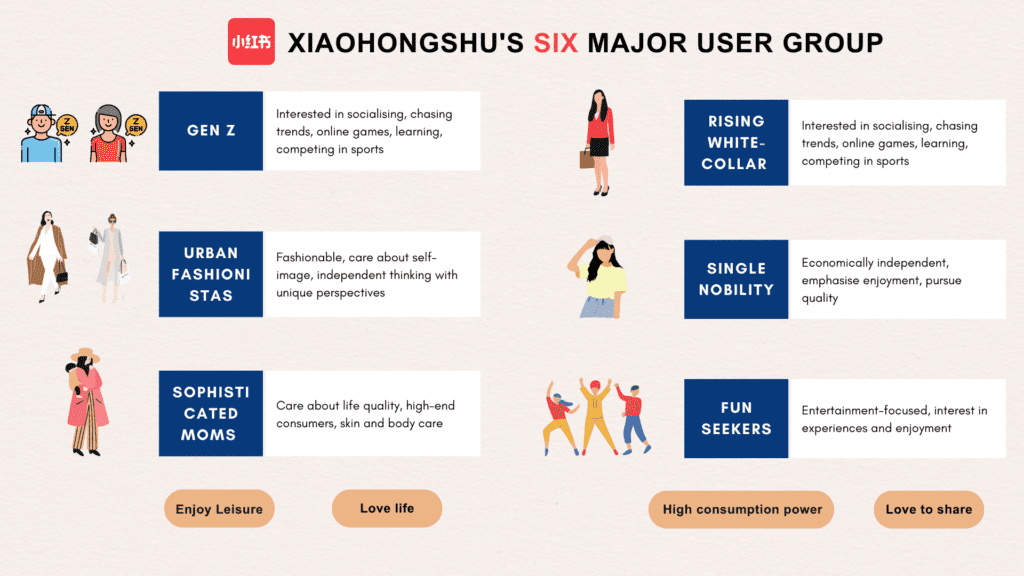
Therefore, brands that take the time to understand the nuances of Xiaohongshu users’ needs and preferences will develop engaging content. This content then has the power to authentically influence lifestyle decisions and build lasting affinity between brands and consumers.
Xiaohongshu Market Operation
Xiaohongshu offers powerful brand exposure and aggressive fan growth for companies looking to grasp user attention and increase purchase power. A successful Xiaohongshu marketing strategy utilises a multi-tiered approach with different levels:
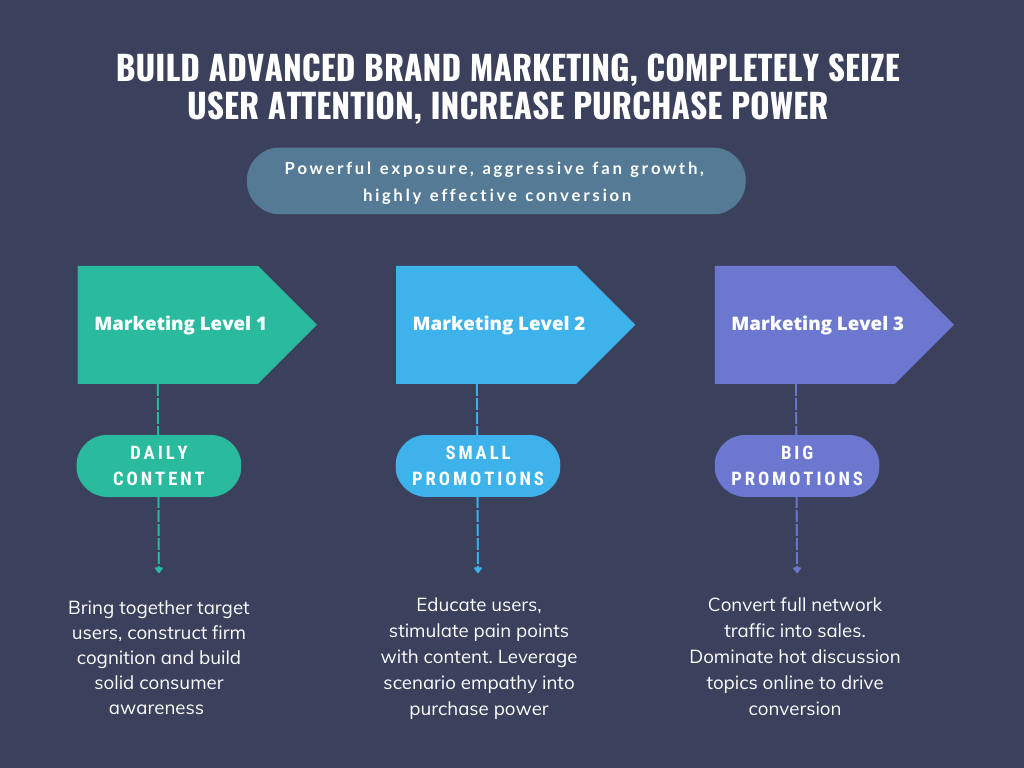
Level 1 establishes basic product awareness through publishing daily content that educates users about the brand and products. This can include posts showcasing product features, how-to tutorials, behind-the-scenes content, etc. For example, a makeup brand can showcase its new lipstick shades. The goal is to introduce the brand to users and build initial recognition.
Level 2 goes beyond basic information and stimulates user pain points and interests through small promotions and tailored content. For instance, a skincare brand could create content to combat dry winter skin. This further engages users by addressing their specific needs.
The top Level 3 converts existing awareness and engagement into sales. Major promotions leverage Xiaohongshu’s large user base and network effects to maximise reach. Influencers, contests like giving away free products, and sales drive conversion by capitalising on established demand.
Brands should also focus on targeted user acquisition throughout the multi-level process, building emotional connections through scenario-based content and dominating hot discussion topics to drive viral spread.
With proper strategic planning using this tiered approach, Xiaohongshu can completely capture user mindshare, drive conversation, and dramatically boost brand purchasing power. When utilised effectively, the platform provides unmatched exposure, fan growth, and conversion.
The Core of Xiaohongshu Explosive Marketing – User Retention and Conversion
While an effective multi-tiered marketing strategy is vital for initial user acquisition and awareness of Xiaohongshu, brands must also focus on retaining and converting users in the long run. After attracting users through educational content, promotions, and influencers, the real challenge begins – keeping them engaged and driving sales.
A core focus for explosive Xiaohongshu marketing is user retention and conversion. There are two key challenges. First, single-user operation and distribution methods cannot maintain high interaction frequencies for each user over the long term. Engagement inevitably drops off over time. For example, sending the same type of newsletter weekly will not keep a user engaged for long. Second, there is often a low user conversion and retention rate, leading to high user churn. For instance, only 10% of users might make a purchase after signing up.
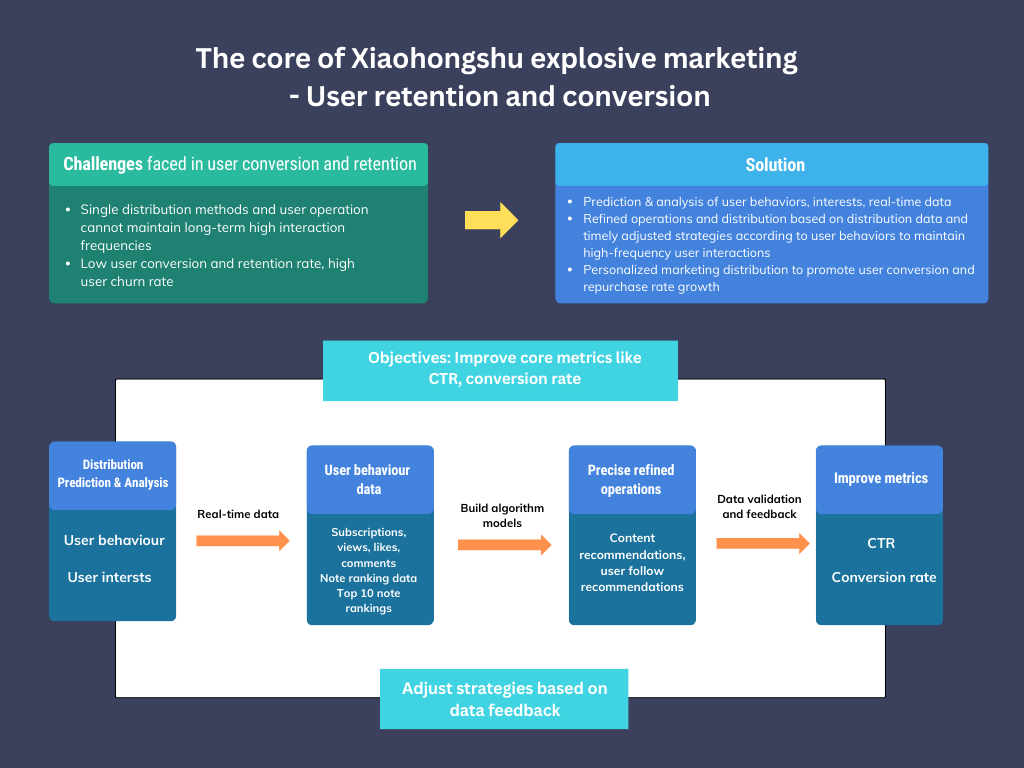
Therefore, to address these issues, solutions involve leveraging prediction and analysis of user behaviours and interests using real-time data. This enables refined, personalised operations and content distribution to maintain engagement. For example, by tracking that a user clicks on makeup reviews but ignores baby care content, Xiaohongshu can customise content to focus on makeup. In addition, strategies can be timely adjusted based on user behaviours to promote conversion and repurchase. If a user does not make a purchase in two weeks, you can send promotional makeup offers to encourage conversion.
The key objectives are to improve core metrics like click-through rate (CTR) and conversion rate. This requires fully adopting available user behaviour data and building algorithm models to power recommendations and rankings. For instance, machine learning models can optimise user feed content ranking. Optimising all types of content, user follows, subscriptions, views, likes, comments, and note rankings is crucial. With precise targeting of users and continuous optimisation based on data, Xiaohongshu can drive user retention and conversion over the long term. The result is explosive viral growth and a positive feedback loop of data optimisation.
Realising Business Success via Xiaohongshu’s Features
Mastering Platform Algorithm
Out of the twenty posts we made within three days, 60% of our content consisted of short videos, while the remaining 40% were text and image-based. Surprisingly, four of the top-performing posts were ALL videos, garnering over 80K views as well as thousands of likes and favourites, resulting in hundreds of new fans within hours of posting.
Cecilia LI
Optimising Xiaohongshu Keyword Marketing Strategy / Search Engine (SEO)
How expensive is traffic? I believe everyone is already well aware. The cost of effect ads on Xiaohongshu is also gradually increasing. Under this condition, most brands have shifted from competing on quality to competing on capital; after all, you need money to afford traffic and the users to see the traffic; otherwise, there is no talk of purchases.
The advantage of Xiaohongshu lies in obtaining traffic by optimising content. The traffic from content is infinitely close to “free” because as long as the content created is attractive, there will be traffic. As long as you rank high for keywords, you can be more easily clicked. Although everyone has different ways to get traffic, the search algorithms still leave traces to follow.
Keyword Selecting Process
So, how did you choose our keyword?
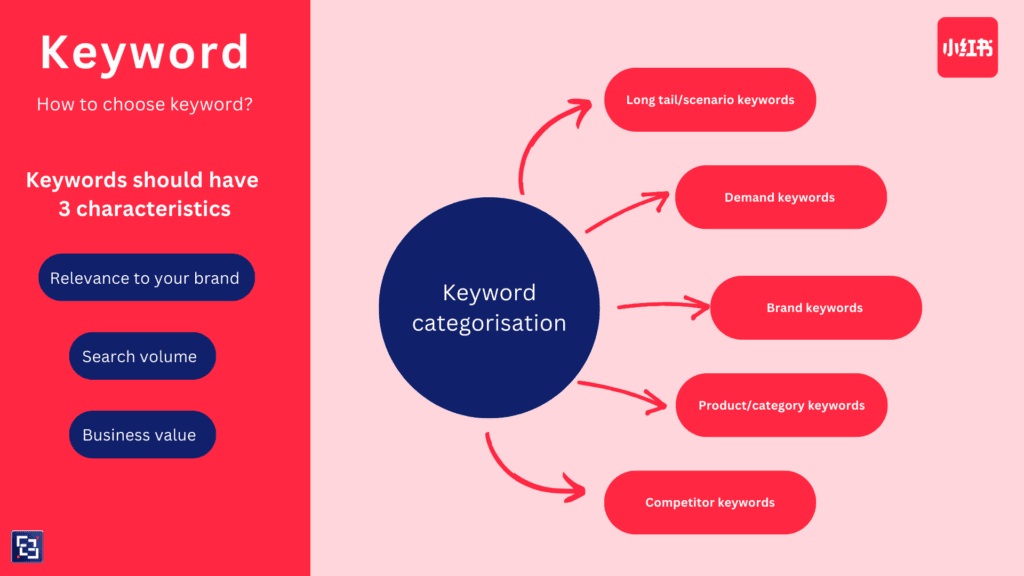
Here are the three characteristics that your keyword should have:
- Relevance to your brand – You want to focus on keywords closely aligning with your brand, products/services, and target audience. You will need more than ranking for irrelevant keywords to drive qualified traffic to your site. Choose keywords that someone would logically search for to find your business.
- Search volume – Keyword search volume indicates how many people search for a term each month. High-volume keywords have more search demand, but low-volume keywords can be easier to rank for. Ideally, you want a healthy mix of high to medium-volume keywords to get traffic while still ranking well.
- Business value – Not all keywords are equally valuable for generating business results. Keywords that indicate buyer intent, like “buy X product”, are more valuable than broad informational terms. Also, consider metrics like conversion rate, average order value, and ROI for your top keywords. Focus on growing keywords that bring in high-quality customers.
Now that we have covered why relevance, search volume, and business value are key characteristics to analyse when researching keywords, let’s look at some of the different types of keywords you may want to target.
Keyword Categorisation
Long tail/scenario keywords
Long tail and scenario keywords refer to non-target keywords that are related to the main keywords and can also bring search traffic. They usually combine two to three words or short phrases extended from the core keywords. For example: “What to give boyfriend as a 520 gift”, “which brand cosmetics is best to do eyelashes”, etc.
Demand keywords
Users base searching demand keywords on real needs descriptions. For example: winter outfit ideas, small handbags, etc. The search ads for this type of keyword can quickly become too broad and are not a main investment direction. But demand keywords represent precise user needs, so when users search for these keywords and see the brand’s content notes, it is easier to convert to precise planting of ideas; that is, demand keywords increase the brand’s exposure probability to a certain extent.
Brand keywords
For example: Lancome, Estee Lauder, Aesop, etc. When doing marketing promotion, the target audience is the brand’s old customers or customers who have some understanding of the brand. The right brand keywords should radiate and expand from product functions, competitors, and platform hotspots, then use data and manual analysis to understand the keyword situation and users’ perception of related words, and finally, determine the brand keywords through layered screening, ensuring optimal keywords.
Product/category keywords
Product category keywords contain the major or subcategories of the brand’s products or services. Product name keywords can specify the exact names created by the brand for promotion, such as Aesop Parsley Seed Anti-Oxidant Serum, Lancome Little Black Bottle, Kiehl’s Creme de Corps, etc. Users can simply remember and associate these, achieving an associative memory effect.
Competitor keywords
These usually consist of a brand name + product name. For example: Yadi Electric Bike, Lancome Foundation, and Estee Lauder Foundation are competitor keywords. Competitor keywords are the most important part of search engine marketing. One of their functions is keyword slotting and ad interception, which can directly capture precise traffic and compete for the opponent’s customer base.
How to layout keywords
Now that we have reviewed some of the different keyword types, let’s discuss how to lay these keywords on your site pages effectively. Proper keyword layout is crucial for optimising different types of keywords and enhancing user experience.
Include keywords in the title
The title is an important basis for users to search the content. The title reveals the content tags and direction, so the article title must contain keywords, and the earlier, the better.
Reasonably distribute keywords in the opening and body
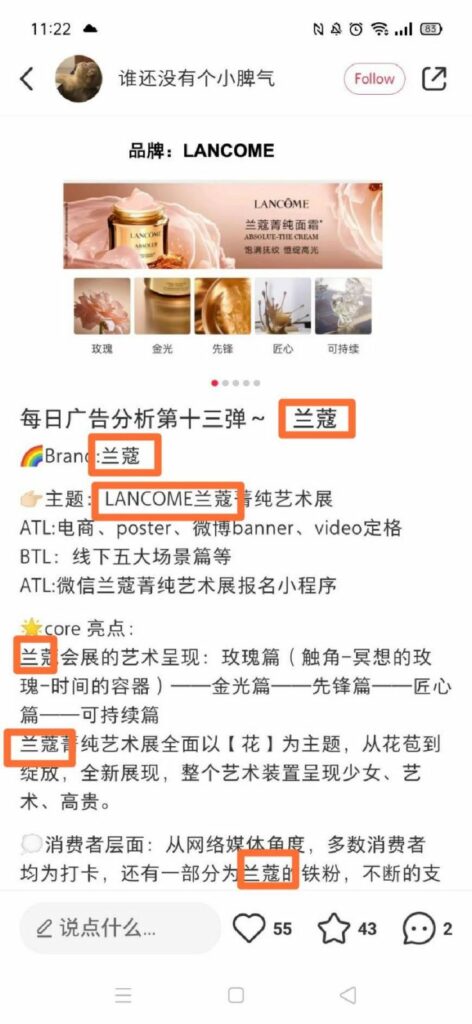
You should incorporate the target keywords in the opening of articles to establish the central theme. You can then develop all content within the piece to revolve around that primary keyword. Adopting the user’s mindset is crucial when creating content.
Writers should visualise what terms and phrases users will likely enter into search engines to find information related to the article’s focus.
These insightful, high-demand user keywords should drive the content structure from the headline down to the concluding sections. By crafting articles around targeted keywords that deliver value to users, writers can boost visibility and engagement on the platform.
Put keywords in tags and endings
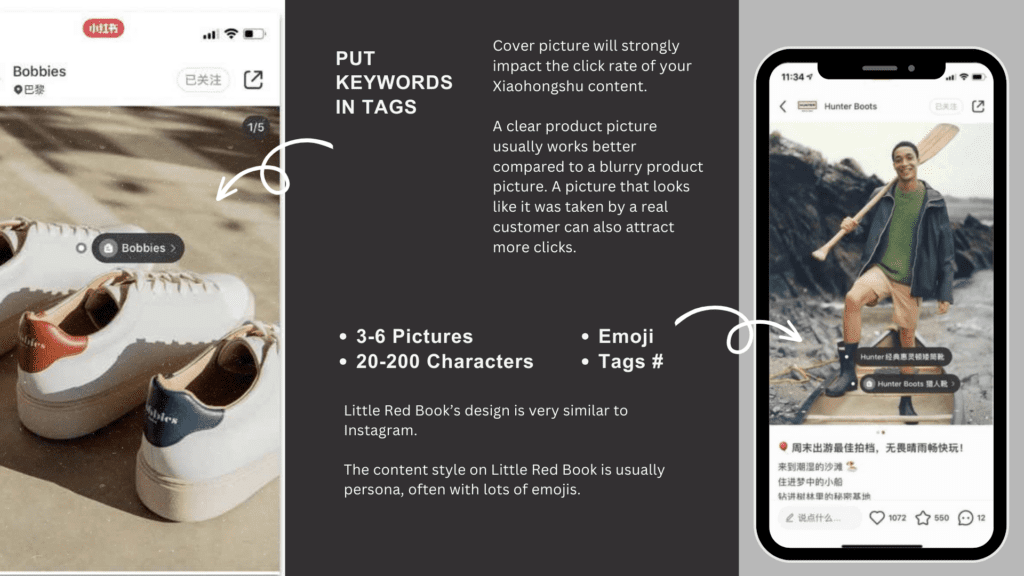
In images, you can add keyword tags. Try to add keyword-related topics at the end and choose topics with high popularity as much as possible.
Include keywords in comments
Likes, saves, and comments on Xiaohongshu are direct feedback on the user experience being good or bad, so a lot of user interaction is crucial. Comments have high weight, and there are also techniques – the copy in the comments can consciously contain optimised keywords to increase keyword density.
Strategies for Successful Xiaohongshu Marketing
Creating High-Quality Content
The most important influence of Xiaohongshu’s traffic on creators is that content must deliver value to users. This means making posts that are visually appealing, informative, and engaging to your target audience. Users must find the content valuable enough to like and save for your posts to rank higher in search results.
Creators should provide useful, engaging content that addresses user needs and interests. The more a note resonates with the target audience, the more user engagement it will drive through likes, saves, and shares. This user engagement then signals to Xiaohongshu that the note offers value, leading to increased visibility and organic traffic growth.
In addition, it is a good idea to incorporate posts that inspire or provoke questions into your new account. Content that encourages audience participation tends to be highly engaging. For instance, we saw great responses in posts showcasing cocktail recipes and prompting viewers to share their favourite custom drink combinations. This interactive content drove high engagement as people shared variations and debated ingredients.
This strategy of driving engagement through inspirational and discussion-provoking content proved highly effective for expanding your reach and establishing brand affinity.
Also, AI is helpful when you know how to utilise it effectively. It can help you stay up-to-date and appeal to the interests of Xiaohongshu users. For photo content creation, consider leveraging AI-generated images from platforms like MidJourney that specialise in producing visually appealing graphics tailored to your needs. For writing post articles to enhance your content with high-converting copies, leverage Seashell AI copywriting solutions that produce persuasive messaging tailored to your brand voice and audience.
Collaborating with influencers, KOLs and KOCs
Collaborating with influencers, key opinion leaders (KOLs), and Key Opinion Consumers (KOCs) is a powerful Xiaohongshu marketing strategy.
By partnering with influencers in their respective niches, foreign brands can leverage the trust and influence these online personalities have on Chinese consumers.
However, you will need to know that it requires careful planning and execution across several phases:
First Phase – Partner with Key Opinion Consumers (KOCs) for daily coverage specials penetrating user segments. These micro-influencers have a niche but engaged followers who trust their recommendations. By partnering with KOCs across various verticals, brands can ensure word-of-mouth diffusion to drive broad awareness. The credibility of these grassroots influencers reinforces the brand perception.
Second Phase – Build ongoing relationships with vertical KOLs in each target interest area relevant to the product. For example, collaborate with makeup experts for a cosmetic line. Match these subject matter experts to aligned user groups. Develop consistent, in-depth content with the vertical KOLs that spotlights product benefits tailored to those niche audiences. This concentrates influencer firepower to convert aware users into buyers.
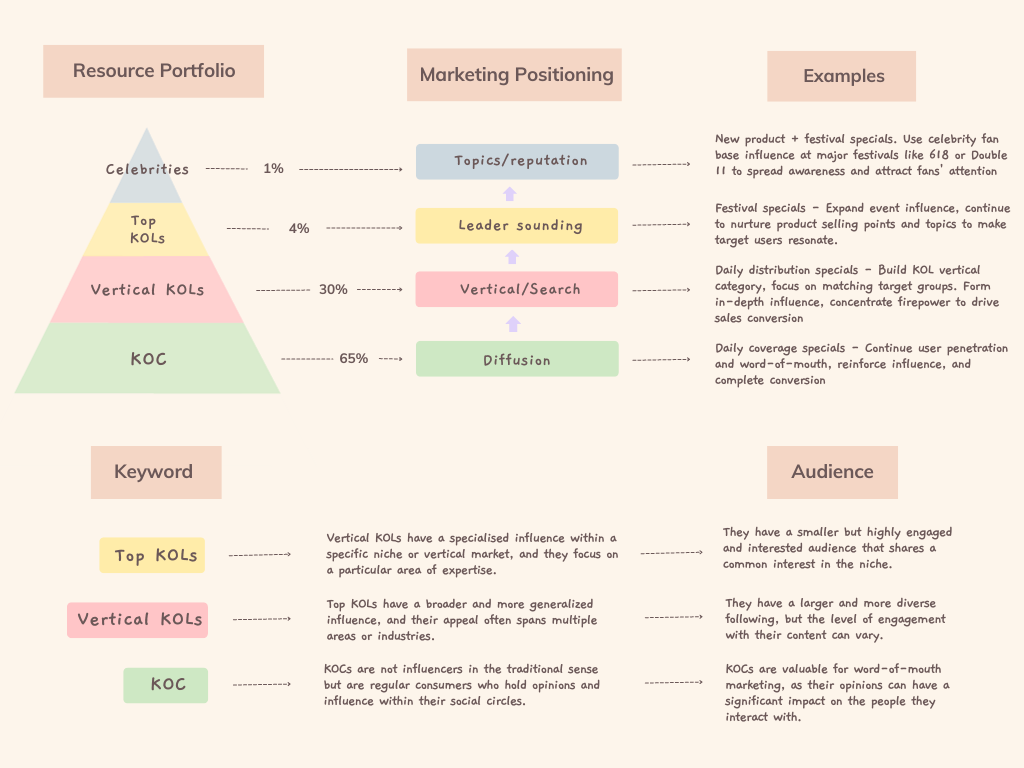
Third Phase – For major shopping festivals and seasons like 618 or 11.11, collaborate with top-tier KOLs and industry leaders to maximise event exposure. Work with these influencers in advance to nurture selling points and topics that resonate with target users during the peak promotion windows. Their existing authority expands reach and impact.
Fourth Phase – Finally, leverage celebrity fan bases by partnering with popular actors or idols for new product launches. Their fame provides credibility, and their extensive following serves as a readymade audience. This spreads awareness rapidly to the massive built-in fan networks during key promotional timing.
Used in concert across the customer journey, this phased approach ensures the right influencer partnerships become fully leveraged to concentrate firepower and awareness on the ideal users. The end result is complete market conversion, driven by layered KOL credibility from initial diffusion to sales conversion to resonance with communities.
How to Balance Organic Reach and Paid Advertising
Getting your brand out there on Xiaohongshu takes a good combo of paid promos and organic content. Paid ads can grab eyeballs quickly, but you want to balance it by keeping things real.
Spend money on promoted posts and influencer collaborations to get on people’s radar. Big reach for the short term. But you must hook them through killer content and authenticity. That is how you turn impressions into real fans!
So, flex your creativity and make that engaging, useful info that the community loves. Be helpful and honest, not just salesy. Build up your squad organically by winning over Xiaohongshu’s peeps the right way.
It is about playing that long game. Paid ads bring the people; then organic content makes them stay. Use both paid and organic together to get maximum traction. Boost your signal, then lock it down.
Be smart about going hard on promos and keeping it real with the community. Do that, and you will smash it on Xiaohongshu, no doubt. Paid provides the spark, but organic fuels the fire.
What is Next?
From the number of monthly active users, you can easily see that Xiaohongshu presents tremendous opportunities for foreign brands. So, you have now gained insights into Xiaohongshu’s marketing strategy. By understanding user behaviours and interests, implementing multi-layered marketing strategies, optimising Xiaohongshu’s unique algorithms, collaborating with influencers, and balancing paid and organic reach, brands can seamlessly integrate into Xiaohongshu’s aspirational community.
Brands should build authentic connections through relatable, lifestyle-oriented content by leveraging the platform’s social commerce model. This inspires trust and affinity with consumers, driving long-term growth.
However, it takes time, commitment, and a lot of exploring. We know that going on a new social media can be scary since you are not in your comfort zone now.
That is why you need a local partner to help you avoid those challenges and give you a clear direction in the long journey. Join our community to explore how we might assist you in developing Xiaohongshu’s strategy plan if you are considering entering the Chinese market.

